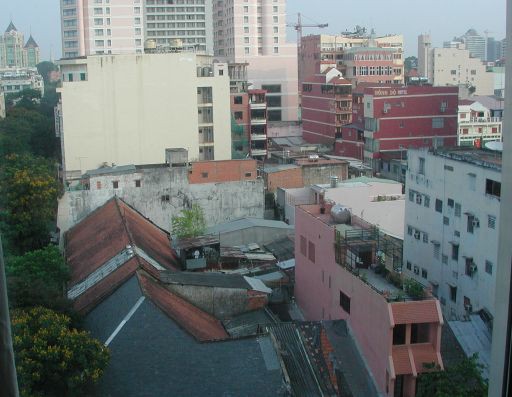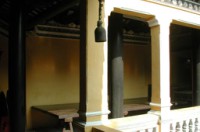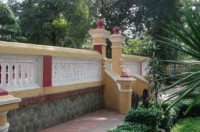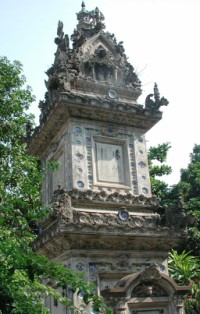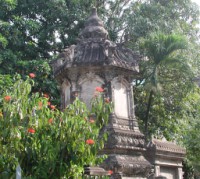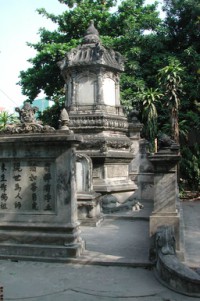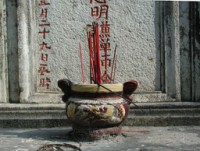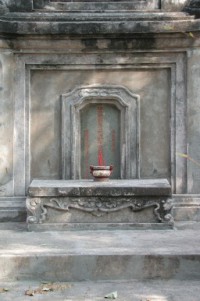In order to cope with the heat and humidity changes from our home environments (roughly a 95% increase in both:) my Mom and I flew in a day early, where we were picked up at the Ho Chi Minh City airport and taken to our hotel. (I was most impressed with my Mom: she actually got one of the guys processing our passports and entry visas to smile. I tried, and failed. This was my first encounter with a real live communist at least I assume those guys in the army have to belong to the Communist party and I admit to being a little intimidated. Mom was kind enough to suggest my unsuccessful grin softened the guy up. At any rate, can you imagine the terminal boredom of processing foreigners paperwork all day? Bleh. Enough to make anyone serious and sour looking. But at least the color scheme of their uniforms olive green with red trim is more handsome than most. Vietnam has an attractive flag, too, a single yellow five pointed star on a red field. In contrast the seal is more complicated, a gear and what I presume are rice sheaves kind of like the logos of older unions, such as the UAW, with that art-deco period style to them.)
To start, here is a picture I took from the window of our hotel, the Grand. We stayed at this hotel twice, with a break to stay at a resort in between. I was immediately enchanted by the outdoor windowboxes filled with orchids. The main desk and even our rooms also had live orchids. The first time we stayed in the newer section, which still (to my feet) had slightly grotty feeling carpet; the second time around we stayed in the older section, with chevron laid hardwood floors. Much nicer. In this, we encountered some differences with US hotels: first, the rooms have real metal keys, which are becoming a thing of the past here; second, the keys come with a plastic tag, which must be inserted into a slot, usually located just inside the door, in order for the electricity to work. The recepticals were, with one exception, dual fit round holes/vertical slots (but wider, I think than standard American slots.) There are no grounds.
These differences we adapted to without effort. American building codes have for years discouraged or outlawed differing heights in thresholds and narrow, steep steps, and these, quite literally, tripped us up. Both of us banged our toes on the threshold to the bathroom, which served to keep water from getting into the room proper. Even the newer section still had rooms with 14’ ceilings, nicely trimmed—obviously a vestige from French occupation.
We'd tried, the day before, to acclimate ourselves to the heat by walking to the Cholon district (No. 5), which didn't seem that far from the central district (No. 1, which is where tourists typically hang out in Saigon) but it proved to be much further than we realized; at any rate, my mom decided to rest up the following morning, whereas I consulted the guidebook, picked out its favorite temple, and decided to go check it out. (Which temple? I dunno. We used the 2004 Vietnam edition of Lonely Planet, which I recommend I liked its overall tone better than the one I checked out of the library, but it went home with my mom, to whom it belongs. I'll have to get it back from her. When I do, the factual and geographic quality of these posts in likely to increase. Substantially.)
I ignored the first guy who tried to give me a motorcycle taxi ride. By the time the second accosted me, I'd concluded that getting a ride would mean earlier (therefore more golden and better) light for my pix, plus it would allow me to interact in a more intimate way with the Vietnamese people. The clincher was the notebook of references he had, written in English, assuring other potential customers of his skills as a tour guide and most particularly his care and safety. Fortunately for me, the guidebook gave recommendations for paying xe om (motorcycle taxi) drivers and thus I probably only paid him 2 or 3 times what I should have.
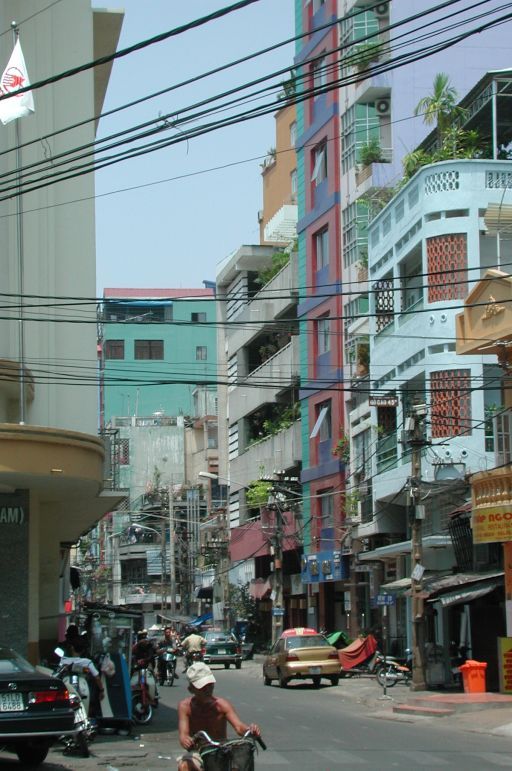
A typical street in Saigon, or, for the politically correct, Ho Chi Minh City; Note the bright colors, low power lines, and the use of sidewalks as extra real estate for the buildings they front, and the overall tidyness...
Of course, I hadn't planned to take a taxi; I was going to walk. So I didn't even have my bike helmet, let alone a motorcycle helmet. I felt naked, especially in the view of the fact that I have never ever ridden a motorcycle (and, until I went to Vietnam, had absolutely no desire to do so). In Vietnam, however, probably some 85% (or more) of the population gets around on these little motor scooters; and practically everybody else, on bicycle. Cars comprise a very small proportion of vehicular traffic, and people, according to my Mom, are much less likely even to commute via bus than in, say, China (which she visited in March).
There is a theory that helmets have made bicycle riding in the US less safe, because of the perceived danger has substantially decreased bicycle riding; well, whatever else you want to say about Vietnamese traffic (and I'll have plenty to say about it later) people do pay attention to cyclists be they scooters, bicyclists, or cyclo drivers and thus, if I had to go without a helmet...nevertheless I still felt naked. However, most Vietnamese don't bother. So I gingerly loaded myself, camera, and backpack, with my newly purchased monopod sticking out the top (a mistake) aboard. And, although riding a motorscooter in Saigon was roughly akin to riding a mule on the Grand Canyon trail, at the same time, scary as both experiences were, I reposed similar confidence in my transportation.
That is, I enjoyed it, despite obsessing over falling off, losing the monopod because the zipper was slowly opening, or totally failing to keep track of where I was going (so I could walk home without getting lost..
Moreover, I once again vastly underestimated the distance, and thus was very glad to a) get taxied there and b) negotiate to get taxied back. And I probably made the driver, Mr Tung, happy for a week. (Btw, he's available by phone from 950.2464 from 7pm–10pm) One caveat: the exhuast pipes of these machines are located on the right of the bike as you face forward. Therefore, you should dismount with your weight on your left leg, that is, by swinging your right leg away. Putting the weight on your right leg means you're apt to brush up against the hot pipe, thereby getting a nasty burn. Mine was less serious–and hurt less–than many of the flameworking burns I've gotten over the years, but because I was unable to treat it right away, and it was such a relatively large area (35x45mm) it took a long time to heal—I spent the remainder of my trip with a cutoff sock over it, to protect the blister from sunburn, kicking it with my other heel, etc. Nor was I only idiot that did this—I saw a Deutsch tourist the next day at the Cu Chi tunnels with a huge bandage on his leg in exactly the same spot. Some nearly 7 weeks later the skin is still marked; and I'll probably have permanent scarring.
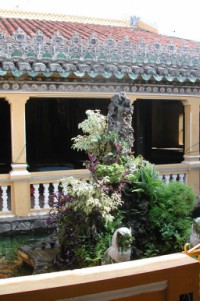
I loved this beautifull courtyard garden growing out of a large, igneous rock. Such rocks are prized, and form a subset of container garden types in Vietnam.
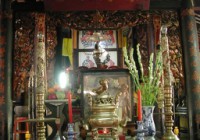
If you look very carefully at the glass case in the large version of this image, you can just barely see some antique French beaded flowers with pink and white petals and yellow centers. This was the only example of such beadwork I saw in Vietnam. In fact, there weren't many beads, and certainly very few glass beads of any kind in Vietnam.

Two sides of the temple were lined with these little shrines, or altars. A guide would later tell me of the five things necessary for a proper offering: flowers; food (especially fresh fruit); light (traditionally, candles); incense; and money (real or “worshipâ€)
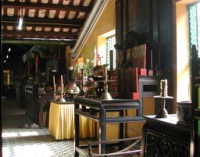
A wider angle view, showing several of the altars. I absolutely loved the light and ambience of this hallway. And the monopod, which I purchased especially for this trip, was absolutely essential in taking pictures of this type: this one was shot at f2.5 at 1/16sec. I can reliably hold this camera—a coolpix990—still only down to 1/30 or so.

This shot illustrates even more clearly my point, as it was taken at 1/4 sec. In this black and white tiled section I was permitted to wear shoes; in the red and black tiled area, I took them off. There I listened to a monk as he chanted and hit a gong: beautiful, but I didn't think it would be respectful to photograph him or that part of the temple (which was extremely dark anyway.)
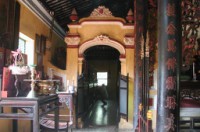
This shot was taken on the opposite side of the room of the earlier altar shots; the black and white tile area is between them.
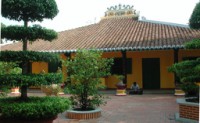
An exterior shot of the temple complex. This pale yellow color is very popular in Vietnam, especially for sacred buildings, government offices, and schools. Note the people taking advantage of the peace and quiet to study or simply hang out, a custom I thought delightful.
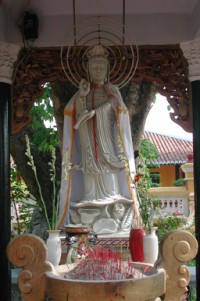
Religious statuary, be it Buddhist, as here, or Catholic (so far as I could tell, all Vietnamese Christians were Catholic) quite often have fluorescent light halos. Not only that, owing to fact that Vietnamese conserve their electricity more carefully than we do, they light their temples with fluorescents of the kind one associates with very utilitarian areas in the US, thus giving these spaces a curious feeling of the sacred and mundane.

The sheer age of this safe, used for donations, captured my imagination (as well as some money.) Vietnamese, which is a tone language like Chinese, originally shared its character set as well. However, in the 1700s, French Missionaries adapted the roman character set (with diacritical marks to represent the six tones). This system was eventually adopted for its greater ease of use, and is now the standard.
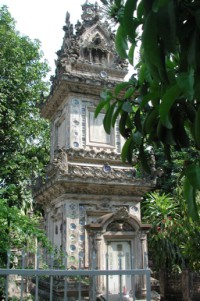
I believe this a grave, or at least, a memorial. At any rate, I just loved the shape and texture of this space...
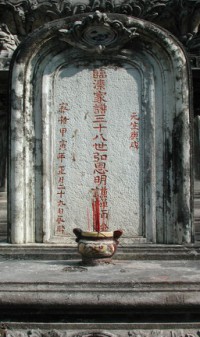
...followed by three closeups of incense. That coiled black thing in the foreground is not trash, but the remains of a piece of coiled incense. Coiled incense is much more expensive, and last much longer, than the stick kind.
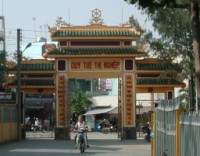
This is the outer gate, as seen from the inside of the complex: Mr Tung took me all the way in, but realized I would like to walk out, and so patiently accommodated me as I clicked my slow way out.
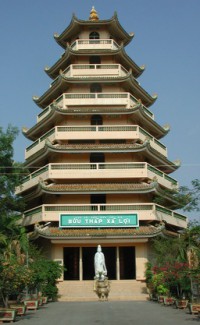
This is a different temple. As I'd promised my mother I'd be back more or less at a certain time, I didn't feel I could take the time to go in, but I certainly enjoyed the chance to get a quick shot of the exterior.
The Giac Lam Pagoda was indeed beautiful and I'm very glad I went, but sometimes, it's little unexpected things that affect you. I remember years ago my mother in law telling me that the part she liked best about visiting foreign countries was meeting the people—and since she and my father in law generally travelled as part of mission groups which arranged “working vacations†in which they would work—usually either building or rebuilding—houses, schools, hospitals or churches—along side the native people, with whom they stayed—this was something she got a real chance to do.
Similarly I hoped to meet Vietnamese people in a more involved way than I would from mere business transactions like registering for rooms or ordering food. Thus my willingness to experiment with the motorcycle taxi. But even more than his care, did I appreciate the efforts of his fellow Vietnamese: the first one told him to stop, and show me how to put my feet on the footrests, which I surely appreciated, as I was getting very fatigued holding them.
The second warned him that I needed to tuck my camera on my lap, rather than letting it dangle from its strap. I had of course read about the motorcycle jockeys who were reputed to steal cameras, hats and even glasses right off hapless tourists riding xe om; and I very happy to report none our group had any such problem. But I was deeply touched by the Vietnamese who instructed my guide to tell me to tuck my camera safely away on my lap, instead of letting it dangle temptingly off my hip on its strap. This completely disinterested kindness welcomed me as nothing else could have.
Next: the Cu Chi tunnels; or return to the Vietnam index.
Unless otherwise noted, text, image and objects depicted therein copyright 1996--present sylvus tarn.
Sylvus Tarn